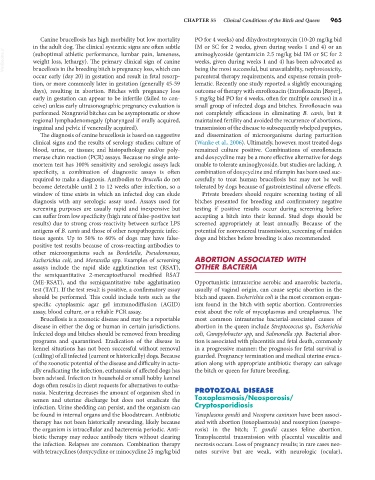Page 993 - Small Animal Internal Medicine, 6th Edition
P. 993
CHAPTER 55 Clinical Conditions of the Bitch and Queen 965
Canine brucellosis has high morbidity but low mortality PO for 4 weeks) and dihydrostreptomycin (10-20 mg/kg bid
in the adult dog. The clinical systemic signs are often subtle IM or SC for 2 weeks, given during weeks 1 and 4) or an
VetBooks.ir (suboptimal athletic performance, lumbar pain, lameness, aminoglycoside (gentamicin 2.5 mg/kg bid IM or SC for 2
weeks, given during weeks 1 and 4) has been advocated as
weight loss, lethargy). The primary clinical sign of canine
brucellosis in the breeding bitch is pregnancy loss, which can
parenteral therapy requirements, and expense remain prob-
occur early (day 20) in gestation and result in fetal resorp- being the most successful, but unavailability, nephrotoxicity,
tion, or more commonly later in gestation (generally 45-59 lematic. Recently one study reported a slightly encouraging
days), resulting in abortion. Bitches with pregnancy loss outcome of therapy with enrofloxacin (Enrofloxacin [Bayer],
early in gestation can appear to be infertile (failed to con- 5 mg/kg bid PO for 4 weeks, often for multiple courses) in a
ceive) unless early ultrasonographic pregnancy evaluation is small group of infected dogs and bitches. Enrofloxacin was
performed. Nongravid bitches can be asymptomatic or show not completely efficacious in eliminating B. canis, but it
regional lymphadenomegaly (pharyngeal if orally acquired, maintained fertility and avoided the recurrence of abortions,
inguinal and pelvic if venereally acquired). transmission of the disease to subsequently whelped puppies,
The diagnosis of canine brucellosis is based on suggestive and dissemination of microorganisms during parturition
clinical signs and the results of serology studies; culture of (Wanke et al., 2006). Ultimately, however, most treated dogs
blood, urine, or tissues; and histopathology and/or poly- remained culture positive. Combinations of enrofloxacin
merase chain reaction (PCR) assays. Because no single ante- and doxycycline may be a more effective alternative for dogs
mortem test has 100% sensitivity and serologic assays lack unable to tolerate aminoglycoside, but studies are lacking. A
specificity, a combination of diagnostic assays is often combination of doxycycline and rifampin has been used suc-
required to make a diagnosis. Antibodies to Brucella do not cessfully to treat human brucellosis but may not be well
become detectable until 2 to 12 weeks after infection, so a tolerated by dogs because of gastrointestinal adverse effects.
window of time exists in which an infected dog can elude Private breeders should require screening testing of all
diagnosis with any serologic assay used. Assays used for bitches presented for breeding and confirmatory negative
screening purposes are usually rapid and inexpensive but testing if positive results occur during screening before
can suffer from low specificity (high rate of false-positive test accepting a bitch into their kennel. Stud dogs should be
results) due to strong cross-reactivity between surface LPS screened appropriately at least annually. Because of the
antigens of B. canis and those of other nonpathogenic infec- potential for nonvenereal transmission, screening of maiden
tious agents. Up to 50% to 60% of dogs may have false- dogs and bitches before breeding is also recommended.
positive test results because of cross-reacting antibodies to
other microorganisms such as Bordetella, Pseudomonas,
Escherichia coli, and Moraxella spp. Examples of screening ABORTION ASSOCIATED WITH
assays include the rapid slide agglutination test (RSAT), OTHER BACTERIA
the semiquantitative 2-mercaptoethanol modified RSAT
(ME-RSAT), and the semiquantitative tube agglutination Opportunistic intrauterine aerobic and anaerobic bacteria,
test (TAT). If the test result is positive, a confirmatory assay usually of vaginal origin, can cause septic abortion in the
should be performed. This could include tests such as the bitch and queen. Escherichia coli is the most common organ-
specific cytoplasmic agar gel immunodiffusion (AGID) ism found in the bitch with septic abortion. Controversies
assay, blood culture, or a reliable PCR assay. exist about the role of mycoplasmas and ureaplasmas. The
Brucellosis is a zoonotic disease and may be a reportable most common intrauterine bacterial-associated causes of
disease in either the dog or human in certain jurisdictions. abortion in the queen include Streptococcus sp., Escherichia
Infected dogs and bitches should be removed from breeding coli, Campylobacter spp, and Salmonella spp. Bacterial abor-
programs and quarantined. Eradication of the disease in tion is associated with placentitis and fetal death, commonly
kennel situations has not been successful without removal in a progressive manner; the prognosis for fetal survival is
(culling) of all infected (current or historically) dogs. Because guarded. Pregnancy termination and medical uterine evacu-
of the zoonotic potential of the disease and difficulty in actu- ation along with appropriate antibiotic therapy can salvage
ally eradicating the infection, euthanasia of affected dogs has the bitch or queen for future breeding.
been advised. Infection in household or small hobby kennel
dogs often results in client requests for alternatives to eutha-
nasia. Neutering decreases the amount of organism shed in PROTOZOAL DISEASE
semen and uterine discharge but does not eradicate the Toxoplasmosis/Neosporosis/
infection. Urine shedding can persist, and the organism can Cryptosporidiosis
be found in internal organs and the bloodstream. Antibiotic Toxoplasma gondii and Neospora caninum have been associ-
therapy has not been historically rewarding, likely because ated with abortion (toxoplasmosis) and resorption (neospo-
the organism is intracellular and bacteremia periodic. Anti- rosis) in the bitch; T. gondii causes feline abortion.
biotic therapy may reduce antibody titers without clearing Transplacental transmission with placental vasculitis and
the infection. Relapses are common. Combination therapy necrosis occurs. Loss of pregnancy results; in rare cases neo-
with tetracyclines (doxycycline or minocycline 25 mg/kg bid nates survive but are weak, with neurologic (ocular),

